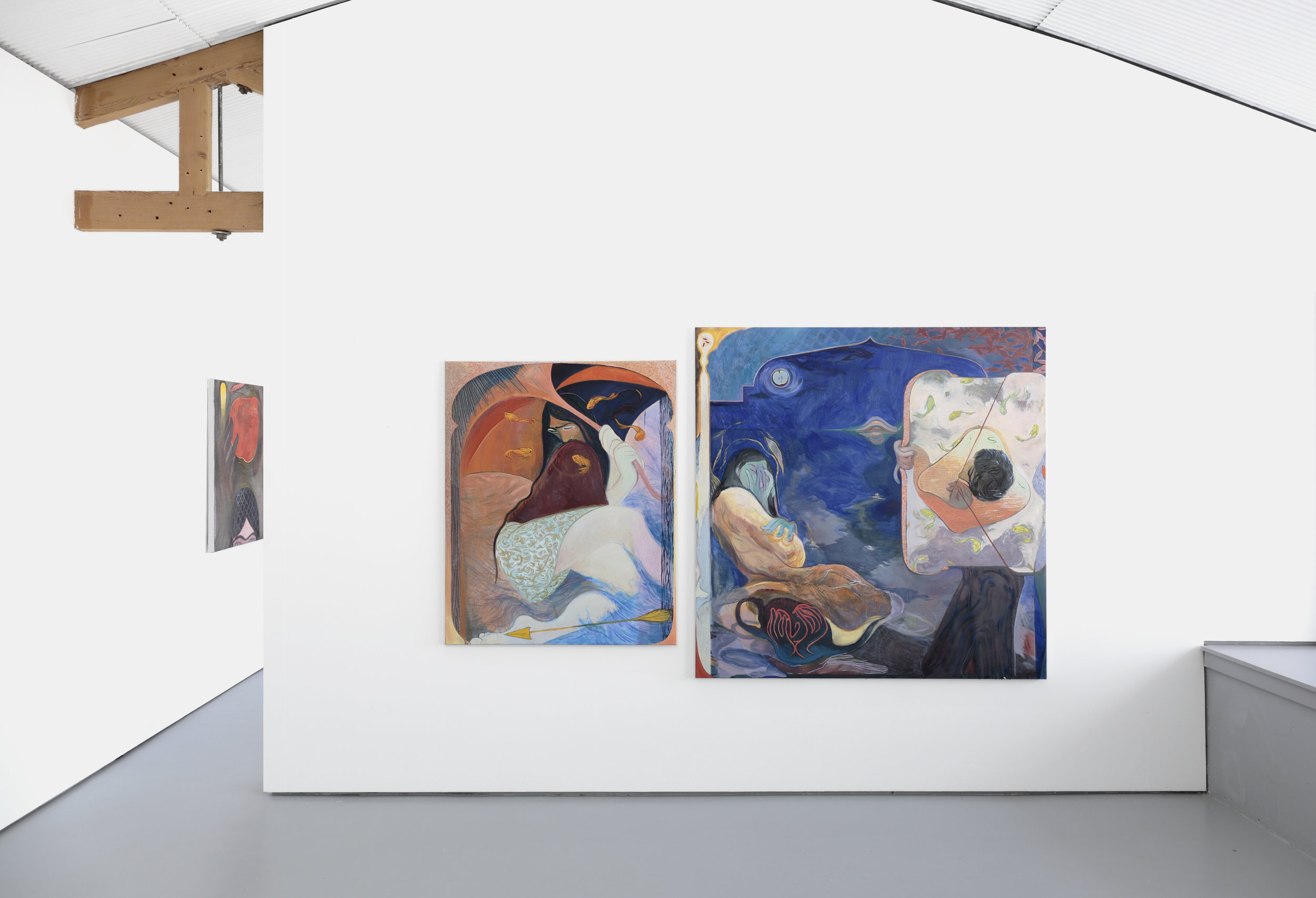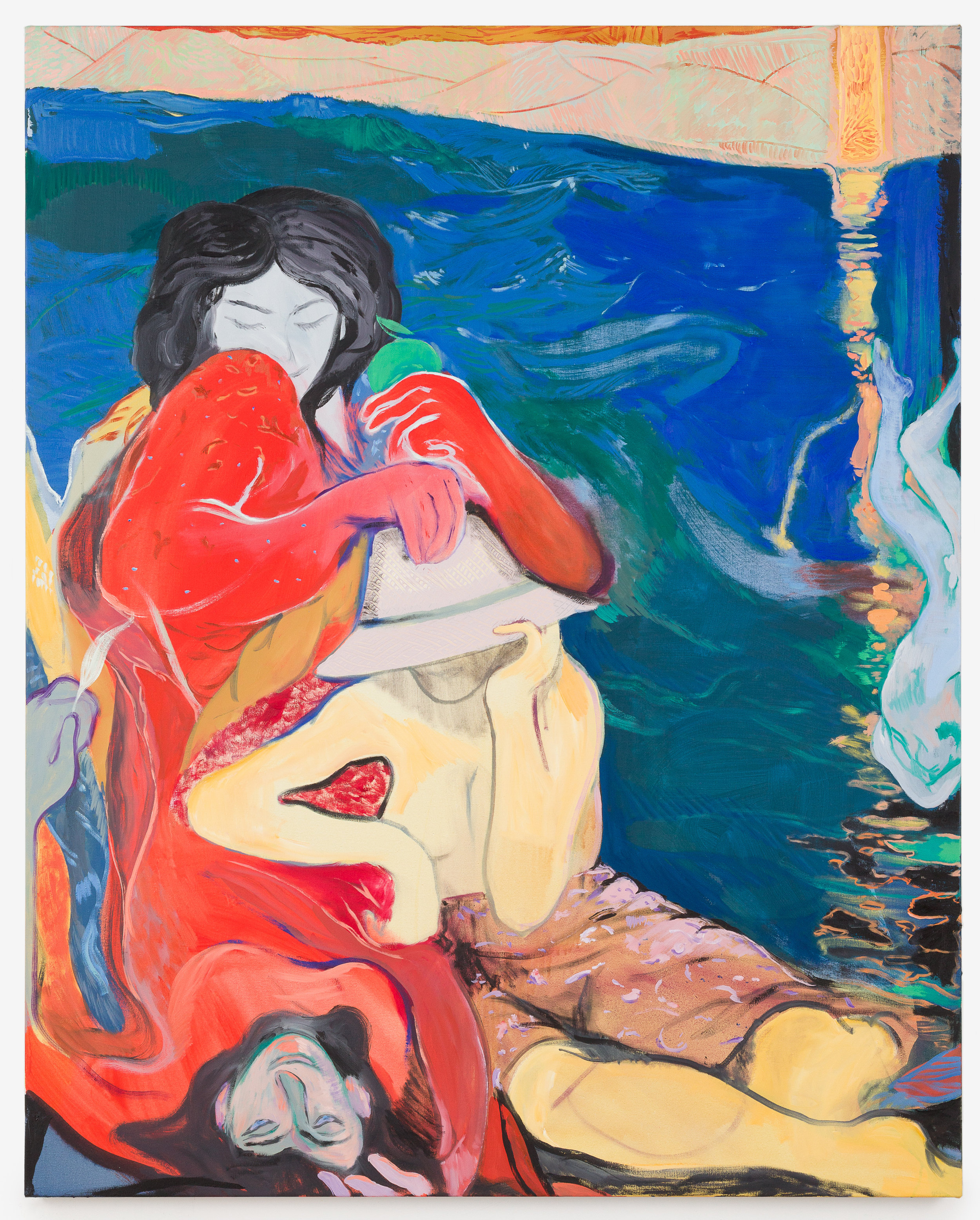Henry Curchod

“I’m really interested in how historically, cultures cross-pollinate myth and symbolism, to the point that now everything has a maze of traces and alleged origins. I started with this idea, but as all shows do, it grew into completely new territory.”
Interview by: Isabel Sachs
Could you tell us a bit about yourself and your background? Where did you study?
I am a painter currently living and working in Sydney, Australia. I completed a BA/BFA at The College of Fine Arts, Sydney in 2014, but I was born and grew up in San Francisco.
Your work draws inspiration from a popular tale with various depictions across cultures. What was your process in creating these particular scenes? Did you consider the theme first or did it present itself during the making of the pieces?
Well, there’s a lot in there exploring my Persian heritage . The narrative itself is a kind of re-fragmented amalgamation of every culture’s take on the common William Tell myth. The term ‘Apfelschuss’ (translates to ‘apple-shot’ in German) was coined by the Swiss who claim origination of the tale. Every culture has their version. There’s a Turkish version, a Chinese version and a Persian version. Mine is somewhere between the William Burroughs’ version and the Iranian one.
I’m really interested in how historically, cultures cross-pollinate myth and symbolism, to the point that now everything has a maze of traces and alleged origins. I started with this idea, but as all shows do, it grew into completely new territory.
I tried to bring this idea of narrative fragmentation into the composition and construction of the images, so as to use the idea as a way to disrupt the viewer’s physical relationship to the canvas. This led to a serious exploration of architecture in painting. As a means of internal framing. So I have been playing with Islamic architecture, which is getting a lot more ‘play time’ in the studio. I mean, originally these complex structures were the work of secular Persian aristocrats, and like Farsi, were absorbed during the spread of Islam in the Middle-East starting between the 6th -8th century. Considering the world’s current climate, this sharing, spreading and diluting of culture and symbolism is something that I’ve been fascinated by for a long time. But in answer to your question, everything in art is the process of building and letting go; or release and restraint, and themes should work like that too. You can’t marry your subject.
Setting the table 2019
fish whispers 2019
If a tree falls in a fores 2019
What made you gravitate to painting as your main practice?
Drawing was my first love and it is still the underlying foundation to all my work. But everyone draws, so that’s just a common foundation. I think at a very young age I was building things from scrap materials in my father’s and grandfather’s workshops. They were engineers and always encouraged the practical implementation of manic creative behaviour. But to their dismay I steered towards making things with regressive practical applications. And this pattern just never ended. I’ve wanted to be so many things, but in the end there’s no denying what you do. Now it has become a lot more serious than something ‘I should do’, it has become much more complex.
So early on I focused on painting in such a way that I could never leave it, and it became one of the only reliable constants in my life. Now my relationship to painting is very similar to the relationship of a significant other. Painting is personified, we live with each other indefinitely, we have good periods and we fight. It’s a healthy projection.
How do you approach colours? Do you attach symbolic meaning to them?
Colour is probably the thing I plan the least. In a sense, there’s always a plan, but you leave blank spaces so the nature of colour is definitely algebraic. With long equations of colour, every solution creates another problem, and it becomes this sequential maelstrom, but you can always push through and find an answer. It might not be ‘the’ answer, but it is ‘an’ answer. And in all great things, I think the most pleasing work for us is reducing seemingly arbitrary and subjective things, into a set of much more significant and solvable isolated problems. For me, colour more than anything else, really lies in that territory.
Tell us a bit about how you spend your day / studio routine? What is your studio like?
I wake up way too early and go on my phone to make sure I haven’t missed the apocalypse. Once I’m certain of that, I start thinking about about the work. The morning is this amazing time for me when everything is so clear and focused. When I get into the studio I will sit and stare at the paintings for a long time, making a list of problems to solve. After a while, I check-off enough of that list to start actually painting. All of the works are made up of several preliminary drawings, so I consult those as well. Then I paint uninterrupted for a long time. It’s a good day if I completely lose track of time. I don’t eat before I paint, to keep a steady pace. I think that physiologically, eating is a productivity death sentence. At the moment I’m watching a lot of professional snooker online. It’s very calming. I think it’s the closest I’ve come to proper meditation. In some way I think it is really starting to inform my practise.
What artwork have you seen recently that has resonated with you?
In person? I see lot’s of art on the internet that I love. Not just new works, but people uncovering vaults of the work of well loved artists. Works I’ve never seen. The internet is great for that. I saw a great Jon Kørner work recently that really excited me. I must have looked at it for a good 10 minutes, still fascinated by his choice making and problem solving. I am interested in frame heavy work , getting a grounding through a kind of micro-spacial architecture and he does that very well.
Is there anything new and exciting in the pipeline you would like to tell us about?
There’s a few good things coming up but they are not announced yet. So no, I can’t really talk about it. I’m just really focused in the studio at the moment. Trying not to get distracted by the pace of everything else. I’ve got two new bodies of work cooking so that’s really exciting. Always trying to keep the momentum.
All images courtesy of the artist
Publish date: 02/04/2019






